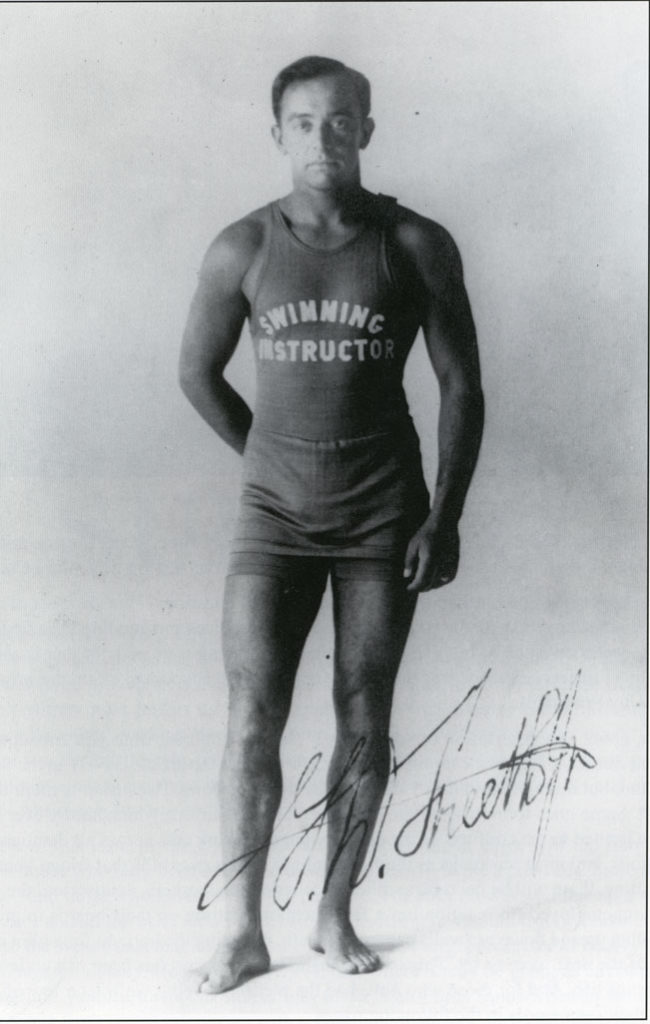Just in time for summer, this month’s Journal Flashback presents an article on the history of surfing in California and Ventura County. Surfing itself dates as far back as 200-400 C.E. and was an important activity in Hawaiian and Polynesian cultures. We will be breaking this quarterly into two segments. The first segment will be the article below, penned by Southern Californian historian and surfer George C. Verge. Stay tuned for Part II for a look at Ventura and Santa Barbara’s surfing community and more local history. This article was originally published in 2000 (Ventura County Historical Society Quarterly, Volume 44, No. 3). Note: This article relates mostly to surfing by white men, who are not the only people who surf today or who have surfed historically. We encourage readers to look into additional resources that better speak to this issue. We offer the following starting points: a Guardian article on Indigenous surfers reclaiming the practice, a KCET article on surfing history, and this Hawaii Public Radio article on the inclusion of surfing in the Tokyo Summer Games and the resulting debate. In addition, organizations such as Native Like Water seek to reconnect Native peoples who were forcibly relocated from coastal areas in California with traditional uses of water. They offer many informative resources.
Surfing is an activity first and last that is personal: breath, light, water, board, heartbeat. And, plainly put, there is no substitute for actually being “OUT,” as in “You going out in the morning?” In the water that is. A three-foot wave, not much more than hip height, looks far different from the prone position most surfers use as they paddle out. Now imagine 5-foot, 8-foot, 10-foot waves either crashing down, sometimes with an incredibly crisp “crack” – in front of you, or chasing you, roaring behind you, throwing you toward the beach; green glass mountain accompanied by its own wind. Impossible to conjure up the real experience. Absolutely have to be there.
Readers of this issue of the Quarterly, like the population at large, will fall into two groups: those who have been out in the water on a board – some a great deal more than others – and those who have not had the pleasure. For both groups we offer up a very subjective and all too brief view of the history of surfing in Ventura County; how it got here (to the West Coast that is) as chronicled by Arthur Verge, professor of history and a Los Angeles County lifeguard since 1974; and where it may be going as envisioned by longtime Ventura surfboard shaper and surfer Stan Fujii. Sandwiched in between1 are excerpts from recent interviews with a sampling of surfers, surfboard shop owners and surfboard manufacturers gracious enough to share their memories: Bill Flores, Jack Herron, Ned Bartels, Jack Cantrell, Tom Hale, Karl Pope, Mary Monks, and Bill Hubina – individuals who have witnessed the evolution of surfing in Ventura County.
In each instance I have asked the interviewee a set of questions – the same set of questions – starting with a request to describe the circumstances surrounding their first time in the water on a surfboard. (The point being that surfing is an activity that is shared. For most surfers, someone was there at the beginning to encourage, point the way or to show by example.)
Now, about this description of surfing as a “sport.” The next time you encounter an article about surfing in the newspaper, notice how often the article is NOT in the Sports section, but more often in the “Life” or “Lifestyles” section. Because it is more than a sport. Same goes for notices of the passing of famous surfers, which hardly ever seem to be limited to the confines of the obituary page. Surfing cuts across all demographic sections, and most mornings as the first sunlight comes over the hills that fringe Ventura’s coastline, there will be doctors, architects, construction workers, dentists and the gainfully unemployed (to mention but a few vocations) sitting on their boards in groups, bobbing up and down as swells pass underneath, watching the horizon for a glint of the top of the next wave or set. This is more than a sport, always has been; it’s undeniably a part of life. And for those who have had the pleasure, well … we’ll let a few of them use their own words in the following pages.
From the Shores of Hawaii to the Sands of
California: The Arrival of Surfing in Southern California by Arthur C. Verge
When George Douglas Freeth boarded the San Francisco-bound passenger ship The Alameda in Honolulu Harbor on July 3, 1907, the course of American history was about to change. Although only twenty-three years old, Freeth was already well known throughout Hawaii for his exceptional water skills. Although both a champion swimmer and high diver, Freeth was best known for his dexterity aboard a surfboard. In May 1907, Freeth, despite his young age, was selected and served as lifeguard for a twenty-four-member United States Congressional delegation that was conducting a fact-finding tour of the island chain. Among those on the tour was adventure author and travel writer Alexander Hume Ford. The meeting of Freeth and Ford would prove to be profound. From their ensuing friendship, the ancient sport of surfing was revived, popularized, and spread to the shores of the United States.
Although Ford was from the American South, and fifteen years older than Freeth, the two men shared many common traits. Both were genteel and blessed with likable personalities. Both were also restless, driven spirits; Ford left his native South Carolina to travel the world, and Freeth left his native Hawaii to settle in various beach locales in Southern California. Importantly, each carried with him a strong sense of purpose.
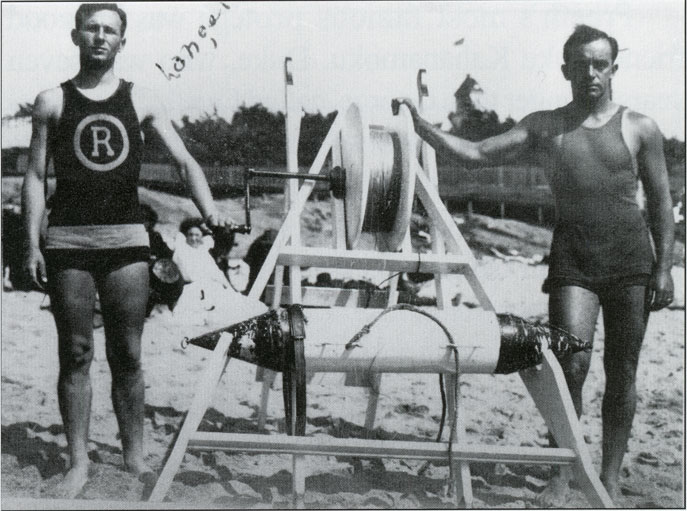
As good fortune would have it, another restless, adventurous soul met these two like-minded individuals in late May 1907. It was Jack London, arguably the most popular writer of the time. From a chance meeting between Ford, London, and London’s wife, Charmian, at the Royal Hawaiian Hotel on May 29, 1907, the sport of surfing would eventually become known worldwide.
London had read much of Ford’s work and enjoyed hearing about his adventures in such places as Manchuria and Siberia. But what caught London’s attention was Ford’s talk of his latest project, which was to document and revive the ancient Hawaiian sport of surfing.2 London was so captivated by Ford’s description of the sport that he agreed to join him for a surfing “session” amongst the waves off Waikiki beach.
When Ford and the Londons made their way down to the sands of Waikiki Beach in early June 1907, they spotted George Freeth far out in the distant surf, speedily riding across a large wave. London, like Ford when he first witnessed Freeth surfing, was enthralled. Mustering their courage, the two renowned authors began to paddle out to join him. London later wrote in his Cruise of the Snark (1909):
Shaking the water from my eyes as I emerged from one wave and peered ahead to see what the next one looked like, I saw him tearing in on the back of it, standing upright on his board, carelessly poised, a young god with sunburn. We went through the wave on the back of which he rode. Ford called to him. He turned an airspring from his wave, rescued his board from its maw, paddled over to us and joined Ford in showing me things.
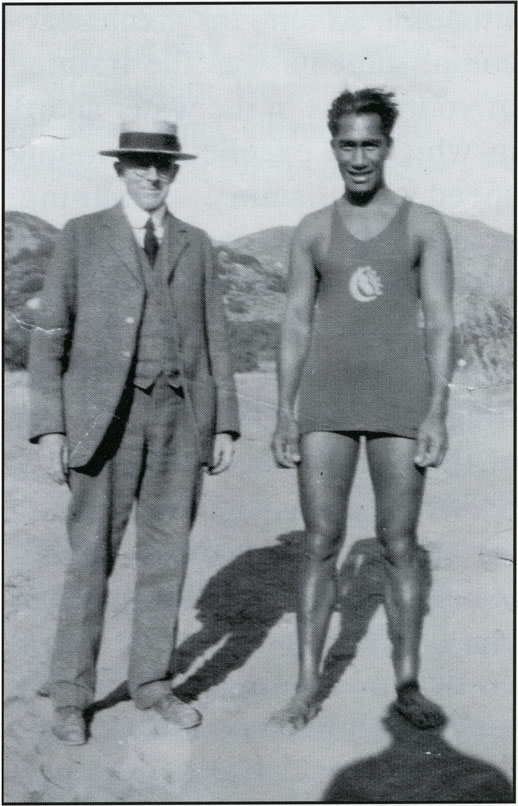
Although Freeth was quiet and humble about his abilities on a surfboard, London, with his typewriter and his popularity, was able to immortalize Freeth, his surfing skills, and the sport of surfing to readers worldwide with the words, “He is a Mercury – a brown Mercury. His heels are winged, and in them is the swiftness of the sea.”
Alexander Hume Ford, too, played a crucial role in promoting surfing, not only through his own writings on the subject, but also with his diligent work in 1908 in helping to create the Outrigger Canoe Club on Waikiki Beach. For Ford, the formation of the Outrigger Canoe Club had a two-fold purpose. First, Ford used the club and its beach locale to encourage and preserve the sport amongst the native Hawaiians. Second, he used the club’s idyllic location to introduce surfing to visiting tourists. On both accounts his plan worked.
Of the three, however, George Freeth had the greatest impact. Freeth physically brought the sport of surfing to the “mainland” and was a tireless promoter of it. With letters of introduction from Ford, London, and members of the Congressional delegation that had toured Hawaii, Freeth arrived in the Los Angeles area in mid-July 1907. On the afternoon of July 22, 1907, a small article in the Santa Monica newspaper, The Daily Outlook, detailed for the first time in Southern California’s history, that the sport of surfing had been demonstrated. The article noted that large crowds were gathering daily along Venice Beach to watch the sport.
Freeth’s impact on surfing was quickly felt. Working with land magnate Henry Huntington in Redondo Beach, and Abbot Kinney in Venice, Freeth drew large crowds to each of their beachfront properties. Freeth performed surfing shows twice daily off Redondo Beach, and at various times served as both a plunge and ocean lifeguard at each of the beaches. It was during this time as a lifeguard and swim instructor that he taught others the sport in which he was so dominant. On Venice Beach, ocean lifeguards there called him the “King of the Surfers.” In Redondo, local advertisers billed him as “The Man Who Can Walk On Water.”
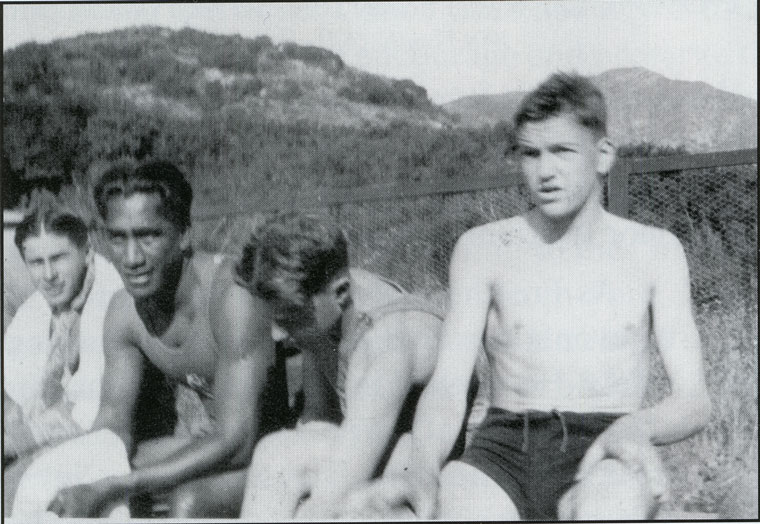
But it wasn’t just his uncanny ability on a surfboard that brought attention to Freeth. He was also a water safety advocate. Given the time period, most plunge attendees and beachgoers had little knowledge of proper swimming techniques, much less what safety measures to practice when in the ocean. Prior to 1909, drowning was a common event, and Freeth took it upon himself to improve this woeful situation. Among his greatest accomplishments was the training of youngsters in the water sports in which he excelled, including speed and distance swimming, board and body surfing, water polo, and high diving. From this young nucleus of watermen would emerge a modern ocean lifeguard service that is the envy of the world today. Additionally, Freeth himself would garner international attention in 1908, with George leading his United States Volunteer Lifesaving crew of Venice in an ocean rescue operation that took more than two hours and saved the lives of eleven Japanese fishermen. For his individual efforts, during which he nearly expired, Freeth was awarded the nation’s highest civilian honor- the Congressional Medal for Valor. At the time, he was only the sixth recipient of that honor in American history.
As Freeth’s stature grew he seemed to be even more bent on teaching swimming safety. He worked in various locations, including stints at the prestigious Los Angeles Athletic and San Diego Rowing Clubs. When not teaching classes or coaching (he brought several divers and swimmers to national and international prominence), Freeth enjoyed spending time out in the surf, often sharing surfing tips with local youngsters. Although none could duplicate Freeth’s ability to do somersaults on a surfboard while riding a wave, many sought to emulate other aspects of his colorful surfing style.
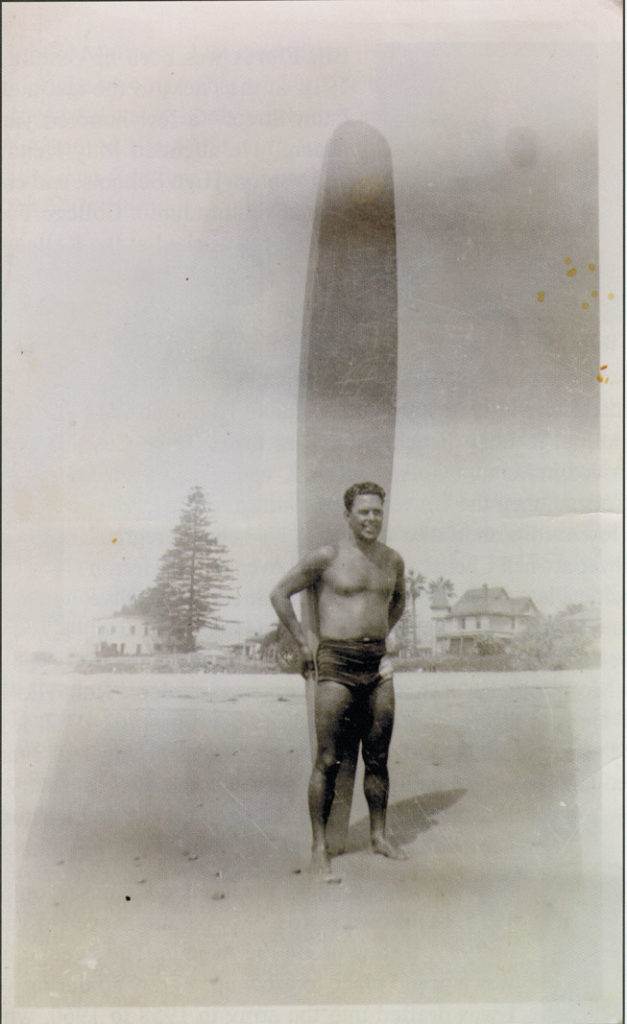
Freeth’s most famous protégé was his good friend Duke Kahanamoku. Duke, who was seven years younger than George, called Freeth, “the greatest waterman I ever knew.” (It is interesting to note that both men had to overcome a natural shyness to perform, teach, and share the joys of swimming and surfing with others, and yet both would be instrumental in popularizing these water sports worldwide). Kahanamoku, like many other young Hawaiian surfers, cared deeply for Freeth. Several times, when they could afford it, Duke and several other Hawaiian beach boys, such as the legendary “Dude” Miller, traveled en masse to the mainland to visit Freeth in both Venice and Redondo.
Sadly, George Freeth’s life was tragically short. Falling victim to the worldwide influenza epidemic of 1918-1919, Freeth died at the age of 35 in San Diego, California. In his wake, however, were now hundreds of watermen and waterwomen swimming and surfing off the shoreline of Southern California.
Despite the passing of Freeth, the sport of surfing continued to grow throughout Southern California. Duke Kahanamoku, rightly called the “Ambassador of Surfing,” continually took local Southern California youngsters out into the water, teaching them the skills of surfing and ocean swimming. His warm, gregarious personality was instrumental in encouraging these youngsters to stay with these sports, and to visit him in Hawaii. As the tourism industry blossomed in Hawaii in the 1920s, growing numbers of Southern Californians flocked to the shores of Waikiki. It was from those shores that surfing continued to flow towards Southern California, forever changing its once empty sands into towel and surfboard-laden pieces of paradise.
Make History!
Support The Museum of Ventura County!
Membership
Join the Museum and you, your family, and guests will enjoy all the special benefits that make being a member of the Museum of Ventura County so worthwhile.
Support
Your donation will help support our online initiatives, keep exhibitions open and evolving, protect collections, and support education programs.
- The interview portion of the quarterly will be shared in Part II of this Journal Flashback.
- While the author is correct regarding Ford and London’s significance, this perspective obscures the cultural significance of surfing to native Hawaiians and other indigenous peoples throughout the Pacific. It’s important to recognize the colonialism of such narratives. KCET has written on article on the topic for those interested in learning more: https://www.kcet.org/shows/earth-focus/the-complicated-history-of-indigenous-knowledge-and-colonial-entanglements-in-surfing.


